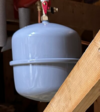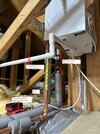I know this is a popular discussion topic....Ive reads lots of threads on it but can't find the answer to my issues.
We live in a 3 bedroom bungalow.
I had an old Potterton gas boiler open vented system. This was located in the loft along with the pump and head tank.
There are 7 radiators on the system. The hot water and heating are on their own zone valves, the only connection between them being a manual bypass valve.
Over the years, we've continually suffered with air ingress to the radiators.
Replaced the boiler with a new Worcester Bosch condensing unit, much more efficient but still giving air ingress in radiators. Replaced the pump with a new grundfoss one. No signs of air at the pump, runs super quiet at mid speed.
I have to bleed one of the radiators every couple of days and get a lot of air out of it. Others need bleeding less often.
After having 3 different plumbers look at it, we made the decision to pressurise the system.
So the head tank for the boiler is gone and the system is now pressurised to 1.4 bar.
There are no signs of water loss at all. However, Im still getting a lot of air in the system.
Like I say - one of the radiators (I think its no 4 in the line) seems to be the main hotspot for air, always needs bleeding almost daily.
I have checked the air from this radiator using a gas meter from my work, its definitely not hydrogen.
So, Im looking for ideas as to how on earth my system is pulling in so much air and where from? Im at a total loss, weekly bleeding of the system is my life nowadays. None of my local plumbers knows what's going on and as mentioned, pressurising the system made no difference at all!
As I say, there's no sign of water loss, the system holds pressure and doesn't need topping up.
Some photos attached if it helps? I can always take other pics if required.
Thank you in advance for any advice you might offer.
cheers
Andy
Last edited:





